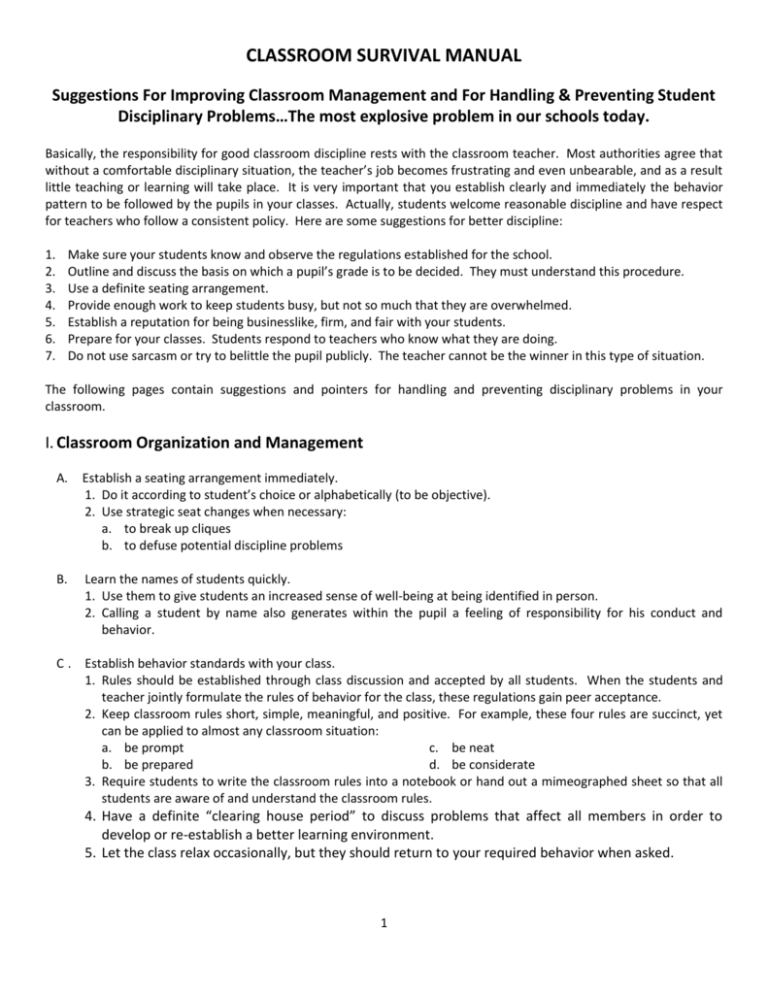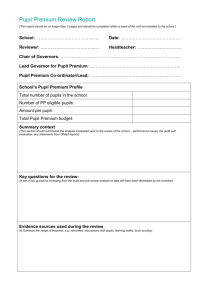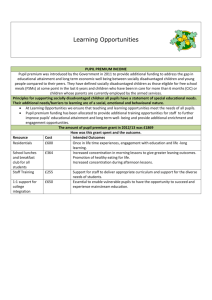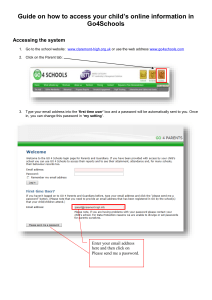Classroom Survival Manual
advertisement

CLASSROOM SURVIVAL MANUAL Suggestions For Improving Classroom Management and For Handling & Preventing Student Disciplinary Problems…The most explosive problem in our schools today. Basically, the responsibility for good classroom discipline rests with the classroom teacher. Most authorities agree that without a comfortable disciplinary situation, the teacher’s job becomes frustrating and even unbearable, and as a result little teaching or learning will take place. It is very important that you establish clearly and immediately the behavior pattern to be followed by the pupils in your classes. Actually, students welcome reasonable discipline and have respect for teachers who follow a consistent policy. Here are some suggestions for better discipline: 1. 2. 3. 4. 5. 6. 7. Make sure your students know and observe the regulations established for the school. Outline and discuss the basis on which a pupil’s grade is to be decided. They must understand this procedure. Use a definite seating arrangement. Provide enough work to keep students busy, but not so much that they are overwhelmed. Establish a reputation for being businesslike, firm, and fair with your students. Prepare for your classes. Students respond to teachers who know what they are doing. Do not use sarcasm or try to belittle the pupil publicly. The teacher cannot be the winner in this type of situation. The following pages contain suggestions and pointers for handling and preventing disciplinary problems in your classroom. I. Classroom Organization and Management A. Establish a seating arrangement immediately. 1. Do it according to student’s choice or alphabetically (to be objective). 2. Use strategic seat changes when necessary: a. to break up cliques b. to defuse potential discipline problems B. Learn the names of students quickly. 1. Use them to give students an increased sense of well-being at being identified in person. 2. Calling a student by name also generates within the pupil a feeling of responsibility for his conduct and behavior. C . Establish behavior standards with your class. 1. Rules should be established through class discussion and accepted by all students. When the students and teacher jointly formulate the rules of behavior for the class, these regulations gain peer acceptance. 2. Keep classroom rules short, simple, meaningful, and positive. For example, these four rules are succinct, yet can be applied to almost any classroom situation: a. be prompt c. be neat b. be prepared d. be considerate 3. Require students to write the classroom rules into a notebook or hand out a mimeographed sheet so that all students are aware of and understand the classroom rules. 4. Have a definite “clearing house period” to discuss problems that affect all members in order to develop or re-establish a better learning environment. 5. Let the class relax occasionally, but they should return to your required behavior when asked. 1 6. Enforced your rules: a. consistently b. fairly c. impersonally D. Announced your expectations of the class. 1. Inform students about what you will require them to do in class. 2. Overprepare the lessons for the first few days to impress upon your pupils that in your room classwork is business. 3. Let students know your expectations to reduce student anxieties. 4. Make some of the first lessons challenging and interesting so that students feel involved immediately. E. Have a regular order of procedure. 1. Attendance should be taken at the beginning of the period. 2. Have some preliminary (“preclass”) work on the chalkboard or mirneographed. a. Preclass work encourages students to settle down. b. It provides you with time to take roll or perform other essential routine matters. 3. Begin classwork readily and in a businesslike manner. Stress that students are responsible for work that begins promptly. 4. Discuss the day’s work and answer questions raised by students. 5. Always have work prepared for the entire period. By working until the end of the class period rather than stopping five minutes early, you have fifteen additional hours of instruction each school year. 6. Establish a consistent order for distributing materials to avoid confusion. F. Manage class movements and transitions. 1. You should handle classroom activities with “smoothness” and “momentum.” 2. Smoothness (anti-jerkiness) means to avoid sudden starts and stops during the transition from one subject or activity to another or during an ongoing recitation. These mistakes in smoothness have a negative effect on student behavior. a. changing a topic or goal for some insignificant item for a noticeable amount of time b. interrupting suddenly pupils’ activities with an order statement or question c. lacking poise or sensitivity to group readiness to receive a message d. leaving an activity hanging or incomplete e. mixing two unrelated activities. 3. Momentum means to avoid slowdowns or behaviors that actually make the pace of activities or recitations slow or draggy. For example: a. dwelling on an issue or point which most or all students understand b. fragmenting material, that, unnecessarily breaking down an activity into subparts when it could be done as a single unit. G. Be alert and observant. 1. Develop the ability to always see or know what is going on in your classroom. 2. Convey your alertness and attentiveness to the students. 3. “Overlapping” or taking care of two necessary functions almost simultaneously communicates to pupils an alertness that makes for better discipline. 2 H. I. Schedule a variety of activities. 1. Design activities that allow students to release suppressed energy and emotions. 2. Vary activities to reduce boredom and enhance student interest. Arrange your room attractively and efficiently. 1. The chalkboard should be neat and understandable. 2. Have definite places for materials, chairs, and tables. 3. Use the bulletin board and displays effectively. II. The Teacher in the Classroom The teacher is the first line of authority in the classroom and the school. How the new teacher presents him/herself on the first day determines much of his/her future control. The following suggestions allow you to check your own behavior in the classroom: A. Attitude 1. Be warm, kind, and friendly, but never familiar. a. Do not be a pal. b. Do not ingratiate yourself with students. c. Keep certain distances. 2. Develop a warm sense of humor. a. Enjoy a joke, but end joke time quickly. b. Judge carefully when the time is ripe for using your sense of humor in a given class. c. Do not allow wise or personal remarks. 3. Do not lose your temper often. 4. Refrain from criticism of other teachers or administrators, and do not permit it from students. B. Firmness 1. Insist on being addressed as Mr., Mrs., or Ms. 2. Be definite. 3. Be relatively firm at the beginning of the year, then relax slightly, but without losing control of the class. 4. Be consistent so that students know what to expect of you. 5. Set limits in your class a. Expect students to operate within these limits. b. Realize that setting limits gives pupils a sense of security. C. Teacher-Student Relations 1. Welcome a new student. 2. Be courteous and demand courtesy to you and to other studetns. 3. Do not embarrass a student. 4. Be fair and grade fairly. Refrain from favoritism and “flirting” with the opposite sex. 5. Praise a student. Recognize appearance, performance, friendly manners, etc. 6. Value your student’s confidence. 7. Keep pupils alert. a. Maintain eye contact. b. Stand and move around the classroom while you teach. 8. Assign punishment impersonally and justly. 3 D. Openness 1. Be approachable. 2. Be friendly. 3. Be willing to listen. E. Appearance 1. Avoid noticeable mannerisms. 2. Watch your voice. a. Your voice should be clear, firm, and pleasant. b. Vary its tone and intonation. c. Do not talk continually. d. Your voice can advertise insecurity. 3. Watch your own appearance. a. your own dress should be clean, neat, and attractive. b. Avoid distracting or provocative clothes. F. You do have to be an example. III. The Teacher as an Adult Leader A. Know your students in order to establish a firm and meaningful foundation on which to develop rapport. Learn names quickly to demonstrate your concern for each individual. B. Be concerned for all students. Warm student response and wholesome pupil demeanor are largely a result of the degree of positivism the teacher shows the students. C. Try to maintain an atmosphere in which pupils are free to do the right thing because they are secure in their position in the class and their knowledge of what they are to accomplish. D. Try to direct matter so that students make the right decisions, but if they do not, it is your responsibility to set them right. Remember your role as an adult leader. They may resist at times, but they expect leadership from you. E. Do not force your opinions. Skillfully guide thinking by raising the right questions at the right time. F. Make a habit of encouraging all definite effort, even if results are not exactly as you expect them and want them to be. G. Be impersonal when discussing misdemeanors with a pupil. H. Be personal when discussing the interests, aptitudes, and accomplishments of your students. IV. Attitudes to be Expected from Students. A young teacher cannot expect all students to have or maintain desirable attitudes toward the teacher. The teacher must insist on: 1. Respect for the teacher 2. Confidence in that teacher 3. Loyalty to the teacher and school 4. Friendliness to the teacher 5. Students being corrected when they are out of line 6. Policies being followed and rules being obeyed 7. Students belonging to the class by feeling secure in their status within the class 4 8. Courtesy to teacher and pupil 9. Cooperation with all. V. Causes of Discipline Problems A. In students themselves: 1. Inability to read or work on a level with age group 2. Language difficulties or barriers 3. Lack of previous success in school 4. Unsatisfactory relationship with parents 5. Attempts to meet their own emotional needs in the classroom situation 6. Previous conditioning of various sorts: a. poor listening habits b. poor study habits c. no real interests B. In their non-school environment: 1. Lack of parental interest 2. Irresponsible parents 3. Unstable home life 4. Family financial and economic problems 5. Inadequate diet and improper nutrition 6. Overcrowded families and /or poor housing 7. Television violence 8. Drugs and Alcohol 9. Gangs and weapons 10. Lack of church leadership 11. Apathy and lack of community concern C. In the atmosphere of the classroom: 1. Lack of class organization 2. No opportunity for pupil initiative and responsibility 3. No opportunity to participate in planning and in setting goals in a teacher-dominated classroom 4. Unclear goals, purposes, or assignments: a. teacher cannot be heard b. teacher uses imprecise or indefinite language c. chalkboard directions are not understandable d. insufficient orientation for an assignment-has not been thoroughly discussed 5. No organized plan for handling supplies and distributing papers 6. Atmosphere of tension and competition where students feel insecure 7. Rigid requirements that are the same for every pupil in the class D. In the attitude of the teacher who is: 1. Cold and unfriendly 2. Inconsistent in assignments and requirements 3. Unjust in decisions 4. Frequently angry 5. A cause of pupil discomfort 5 6. 7. 8. 9. Always “right” and settles everything Lacking firmness Lacking understanding of pupil needs as human beings Prone to biting sarcasm or other ways of humiliating a student in front of other students VI. Prevention of Discipline Problems A. Know your students. 1. Know the characteristics of the age group and what is regarded as normal behavior. 2. Do not judge by adult standards. 3. Do not take small matters too seriously yourself, but take care that kindly reminders keep small matters from growing into large ones. 4. Know your students as individuals by consulting available records. a. Learn and use names as once. b. Examine: (1) Previous school record (2) Intelligence rating (3) Reading score (4) Family background 5. Know your pupils better by drawing them out in conversation, letters of introduction, etc., to discover interests, aptitudes and attitudes. B. Realize that our class is composed of individuals. 1. Do not require the same response of every pupil. 2. Allow for various abilities as well as interests in making assignments. 3. Satisfy the need of individuals to make a satisfactory contribution to the group. 4. See that each pupil gets a chance to feel important and useful by performing some constructive service for the teacher or for the group, preferably both. 5. Let each pupil feel your interest in him/her. The teacher must be genuine about this or it will not work. C. Learn to recognize the situations which lead to discipline problems. 1. Tardiness to class: a. Insist on promptness. Do not be lenient. b. Recognize the student who is late through design or carelessness. 2. Disorder in a classroom: a. Teacher should be in room promptly. b. Class must settle to work when the bell rings. If not, quick drill lessons or short test at the beginning of the period will encourage application to work quickly. Take roll promptly. 3. Disobedient and insolent students: a. Ask him/her to leave the room immediately, but be definite as to whether the pupil is to wait outside the door for you or report to the dean, counselor, or principal. b. Maintain your own poise and continue with class. Do not permit a student to break up a class by quarreling with him/her or be forcing an issue. Never argue with a student. Correction of problem must be completed before student returns to classroom. 6 4. Teacher-pupil conferences: a. The clown, show-off, or interrupter should be corrected audibly in class. The pupil’s attitude can be controlled by an impersonal attitude on the part of the teacher who holds consistently to the classroom standard of good conduct. b. Some students should be corrected quietly in confidence. If poor conduct persists, take him/her into the hall or ask for a conference after school. c. Permit a pupil the opportunity to talk. You may find the reason for his/her behavior. D. Refer certain cases to the clean, counselor, or principal. 1. Those whose misbehavior is repeated after many conferences should be referred. 2. If too many discipline problems appear in one class, this may justify regrouping and distributing offenders. Good classroom discipline should not be thought of merely as being strict, but as cause-and-effect relationship. The student should be made aware that certain types of behavior will cause unpleasant results, while other will elicit teacher recognition and praise. If you use this cause-and-effect approach, then most students will naturally develop good behavior attitudes and responses. In summary, you can achieve good classroom control, acceptable student conduct, and real student achievement if you are firm, fair, friendly, consistent and prepared. National Education Association 1201 16th Street, NW Washington, D.C. 20036 Texas State Teachers Association 316 West 12th Street Austin, TX 78701 1-800-252-5407 (toll free) 7







